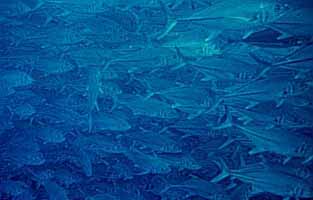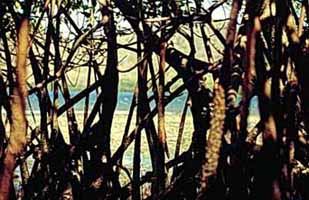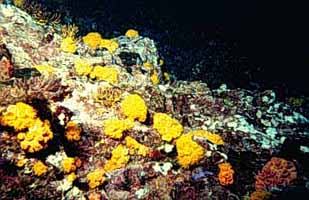

Giovanni Bassey
MARINE AND COASTAL RESOURCES
RESEARCH PROGRAM
 The coastal zone and marine area of the Area de Conservación
Guanacaste (ACG), is composed of approximately 110km of coast and 70,000
hectares of marine habitat, and has enormous biological potential. This
begins in the Bahia Tomas and ends in the Carbonal mountains, and besides
the coastal zone and marine habitat, includes fifteen islands. These are:
the Islas Murcielago, which is probably the biggest archipelago of coastal
islands in Costa Rica, Islas Bolanos, which serve as nesting sites for many
marine birds, and are found in Bahia Salinas, and the Islas de Los Muñecos
and Los Loros in Bahia Junquillal.
The coastal zone and marine area of the Area de Conservación
Guanacaste (ACG), is composed of approximately 110km of coast and 70,000
hectares of marine habitat, and has enormous biological potential. This
begins in the Bahia Tomas and ends in the Carbonal mountains, and besides
the coastal zone and marine habitat, includes fifteen islands. These are:
the Islas Murcielago, which is probably the biggest archipelago of coastal
islands in Costa Rica, Islas Bolanos, which serve as nesting sites for many
marine birds, and are found in Bahia Salinas, and the Islas de Los Muñecos
and Los Loros in Bahia Junquillal.
The main reason that there is such a biological richness in the marine areas of this region is due to a phenomenon called "SURGENCIA", which cools the ocean water in the dry season to temperatures reaching 16C. This phenomenon, which only exists in two other parts of the Pacific coast of America, is caused by the upper layers of the ocean being pushed inward by the trade winds and the cooler, deeper waters laden with nutrients, being brought to the surface, causing an increase in the marine flora and fauna, which has no equal in Costa Rica. The high turnover in this part of Costa Rica is possible due to the fact that the tradewinds go directly to the coast, which is facilitated by the low elevation of the volcanic mountain chain of Guanacaste.
The richness in species is awakening the interest of many marine scientists,
especially in the areas adjacent to the Islas Murcielago, which has influenced
the recent discovery of coral reefs in this area and has led to the creation
of a biological station which is dedicated to the marine investigation,
located in the island of San Jose, the largest on the archipelago Murcielago.
The different coastal areas that are found include: mangrove forests, sandy
and rocky beaches, many inlets that serve as refuges and breeding grounds
for marine birds, rocky outcrops that protect many of the commercial fish
species, and the coral reefs mentioned earlier. Within this richness of
marine habitat is found a huge fish resource, which is one of the most abundant
in the country. There is also a large population of sea turtles and many
of the coral species found in the pacific region of Costa Rica.
Mangroves: are forests that grow in between the area of low and high tide and have plant and animal associations that are characteristic of this environment. The most important of these are the commercial species of fish that lay their eggs here and undergo part of their lifecycles in the roots of the mangrove trees. Besides these fish, different kinds of edible molluscs, such as pianguas, chuchecas, mejillones, and almejas are found. In these areas the juvenile stages of shrimp which are used in Costa Rica are also found.
In the coastal are of the ACG there are six mangrove forests, these are
found in Bahia Tomas, Bahia Santa Elena, Playa Blanca, Playa Nancite, Playa
Naranjo and Potrero Grande. As an interesting aside, these forests present
the characteristics of mangroves in dry and arid regions in Costa Rica,
one of these being a lesser kind of development which is caused by lowered
rates of precipitation and the increased concentration of salt in the substrate.
Out of all of these mangroves, one of the most important is that of Potrero
Grande, because it is the most developed in the area and it marks the northern
limit of the pinuela mangrove in the Pacific region of America.
Sea turtles: In the coastal area of the ACG, the four species of sea turtles that exist on the Pacific coast of Costa Rica are found. These are: the lora , which is the most abundant species in the pacific, the verde, which is the second most abundant species in Costa Rica, the baula, which is the largest sea turtle in the world and is the second most abundant species in the coastal zone, and the carey, which is one of the most endangered species in the world.
It should be noted that, found in the coastal area of the ACG, is Playa Nancite, which is the only restricted beach with huge nesting sites of the lora turtle. Here, thousands of turtles lay their eggs during the later part of the year. This beach is a CRITICAL AREA, which means that the entry of tourists is strongly regulated, the reason being to protect the turtles from human interference.
There are many other areas of interest included in the ACG, one of these
being the WILDLIFE REFUGE OF BAHIA JUNQUILLAL, which is located four
kilometers from the fishing village Cuajiniquil, northeast of Santa Rosa.
Besides its easy access to tourists, there are also camping grounds, nature
trails and the biological diversity, which is characteristic of the coastal
area of the ACG.
|